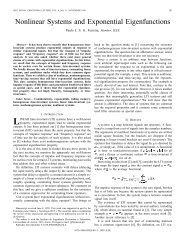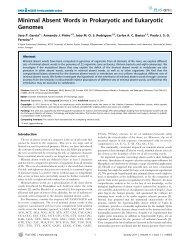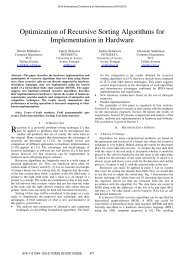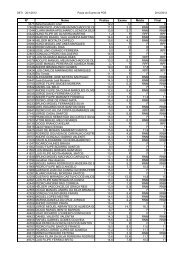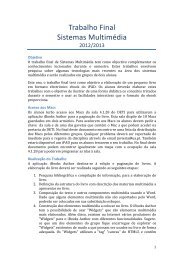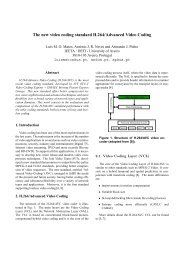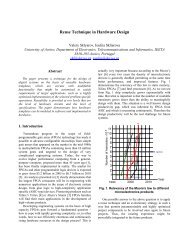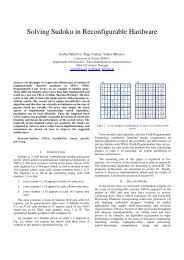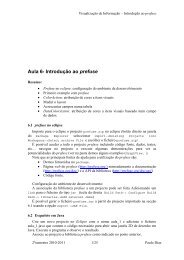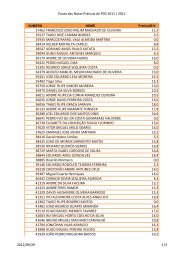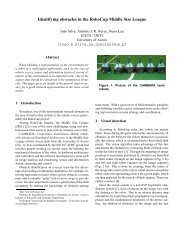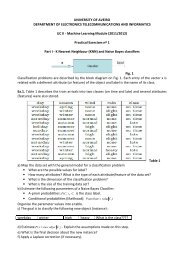Multilevel Models for Data Processing - ResearchGate
Multilevel Models for Data Processing - ResearchGate
Multilevel Models for Data Processing - ResearchGate
Create successful ePaper yourself
Turn your PDF publications into a flip-book with our unique Google optimized e-Paper software.
equire very fast resorting in case of arriving<br />
additional data items;<br />
• Bottom level – as a rule <strong>for</strong> n ≤ 8 or even smaller,<br />
which depends on available resources, where n is the<br />
selected number of the less significant bits of data<br />
items.<br />
Upper level: search a group where<br />
the new item has to be included or<br />
allocating a new group in memory<br />
Middle level: 1. <strong>Processing</strong> binary<br />
trees associated with each group;<br />
2. Creating new groups associated<br />
with leaves of trees<br />
Bottom level: <strong>Processing</strong> items<br />
associated with the leaves of the<br />
trees by sorting networks<br />
Figure 1. <strong>Multilevel</strong> data processing on an example of data<br />
sorting<br />
2.1. Tree walk technique<br />
Suppose we need to sort m-bit data items. Let us<br />
decompose m-bit binary values in 2 N groups that differ<br />
by the N most significant bits. Let us assume that data<br />
items within each group will be sorted by applying some<br />
methods, which we will discuss a bit later. At the upper<br />
level we have to find a proper group <strong>for</strong> any new<br />
incoming data item. In practical cases <strong>for</strong> data with large<br />
bit capacity (<strong>for</strong> instance, more than 64) the number of<br />
groups is significantly less than 2 N . Thus, we can apply<br />
the technique [11] proposed <strong>for</strong> accelerating Boolean<br />
constraint propagation needed <strong>for</strong> solving the SAT<br />
problem with large number of variables and limited<br />
number of clauses.<br />
Figure 2 demonstrates an example, taken from [11],<br />
in which we consider groups instead of clauses. Similar<br />
to [11] the group index walk module uses a tree to<br />
efficiently locate the group associated with any new<br />
incoming data item. The tree will be N/k deep and it is<br />
stored in the tree walk table in an on-chip BRAM block.<br />
Here we consider 2 k -nary trees and N/k is the number of<br />
assigned levels of the tree, through which the walk<br />
procedure from the root of the tree to a leaf (associated<br />
with a particular group) will be done. If k=1 we have a<br />
binary tree. The greater the number k the less number of<br />
levels of the tree we need <strong>for</strong> our walk procedure. Given<br />
a non-leaf node, the address of its leftmost child in the<br />
tree walk table is called the base index of this tree node.<br />
The rest of the children are ordered sequentially,<br />
following the leftmost child. There<strong>for</strong>e, to locate the i th<br />
child, the index can be calculated by adding i to the base<br />
index. If a child is not associated with any group, we<br />
store a no-match (-1) tag in the entry. If <strong>for</strong> a node, all of<br />
its 2 k children have no match, then we do not expand the<br />
tree node and just store a no-match tag in the node itself.<br />
The considered technique is almost the same as in [11].<br />
Root base<br />
index 0000 1 st memory lookup<br />
00 01 10 11<br />
0000 Base<br />
0 1 0001 No 2 0010 No 3<br />
index 0100 match<br />
match<br />
00 01<br />
10<br />
00 01<br />
11<br />
0011 Base<br />
index 1000<br />
0100 No 0101 0110 No 0111 No 1000 1001 No 1010<br />
4 5 6 7 8 9 10 11<br />
match Group 1 match match Group 12 match Group 14<br />
Group 13<br />
10<br />
2 nd memory<br />
lookup<br />
11<br />
1011 No<br />
match<br />
Figure 2. Group index tree work [11] trans<strong>for</strong>med to data sort<br />
Let us consider example from [11] shown in Figure 2<br />
and trans<strong>for</strong>m it to the new problem (i.e. sorting will be<br />
considered instead of the SAT). Suppose k=2, N=4 and<br />
some data items have already been included in the groups<br />
1, 12 and 14. Let the most significant bits of a new data<br />
item be 1101. The base index of the root node is 0000<br />
and the first two bits of the data are 11. The table index is<br />
the sum of two: 0000+11= 0011. Using this table index,<br />
the first memory lookup is conducted by checking the<br />
0011 entry of the table. This entry shows that the next<br />
lookup is an internal tree node with the base index 1000.<br />
Following this base index, adding it to the next two bits<br />
of the input 01, we reach the leaf node 1000+01 = 1001.<br />
This leaf node corresponds to the group in which the item<br />
1101 has to be added. Thus, the no match index will be<br />
replaced with the new group, i.e. group 13 10 = 1101 2 .<br />
New group is indicated by the address of the root of the<br />
relevant tree in memory. Now m-N most significant bits<br />
of data <strong>for</strong> groups (such as the group 13 <strong>for</strong> our example)<br />
will be sorted using tree-like structures.<br />
2.2. Tree-like structures<br />
Tree-like data structures are frequently explored <strong>for</strong> data<br />
processing [10,13]. Let us consider an example of using a<br />
binary tree <strong>for</strong> sorting data [13]. Suppose that the nodes<br />
of the tree contain three fields: a pointer to the left child<br />
node, a pointer to the right child node, and a value (e.g.<br />
an integer or a pointer to a string). The nodes are<br />
maintained so that at any node, the left sub-tree only<br />
contains values that are less than the value at the node,<br />
and the right sub-tree contains only values that are<br />
greater. Such a tree can easily be built and traversed<br />
either iteratively or recursively. Taking into account the<br />
experiments in [14,15] we can conclude that hardware<br />
implementations of recursive and iterative algorithms<br />
over trees give very comparable results in resource<br />
consumption and execution time. We will base our<br />
technique on recursive algorithms just because they<br />
provide more clear and compact specification. The results<br />
of the paper are equally applied to both recursive and<br />
iterative implementations.<br />
Two (following each other) algorithms A 1 and A 2<br />
have to be executed <strong>for</strong> data sort in [13]. The first one A 1<br />
constructs the tree. The second algorithm A 2 outputs the<br />
sorted data from the tree. A 1 executes the following steps:<br />
1) compare the new data item with the value of the root<br />
node to determine whether it should be placed in the subtree<br />
headed by the left node or the right node; 2) check<br />
137



